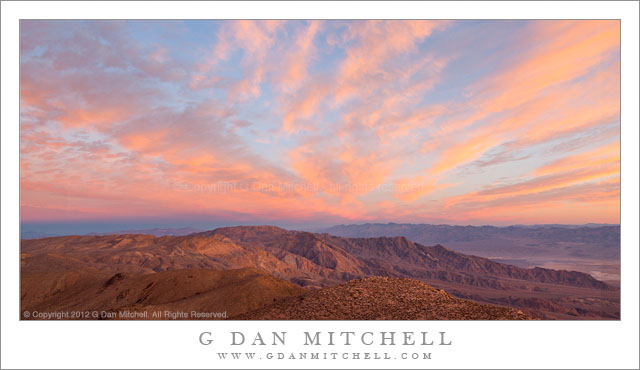Dawn Sky, Panamint Range. Death Valley National Park, California. January 5, 2012. © Copyright 2012 G Dan Mitchell – all rights reserved.
First dawn light on clouds above Death Valley, as seen from high in the Panamint Range
I recently “discovered” (or perhaps “remembered?”) this photograph that I made nearly a year earlier during an early January 2012 trip to do winter photography in Death Valley National Park. Winter is a wonderful time in Death Valley, though the season can present its own challenges – not the same as summer, but challenges nonetheless. The challenges include, believe it or not, the possibility of some very, very cold weather, especially in some of the higher outlying areas of the park an up in the mountains, such as here in the Panamint Range. But there are special rewards, too, including the possibility of snow among the peaks and the more interesting skies that can come with the passage of winter low pressure systems that originate in the Pacific Ocean.
On this morning I had gotten out of my sleeping bag well before dawn so that I would have time to drive to this overlook high in the Panamints before sun rise. It was still dark as I drove the last section of the gravel road approach, and its wasn’t until after I arrived that there was enough light to see that this might turn out to be a spectacular sunrise. (When you get up in darkness and drive many miles, you have to take it on faith that something special might occur, and accept the possibility that it might not.) My original subject ideas for this location were not so much about sky as about deep valleys and receding ridges, but when the first sun hit these high clouds I was willing to angle the tripod up a bit to photograph them! This light on the clouds only lasted a few minutes, and after that I turned my attention back to the landscape below.
 G Dan Mitchell is a California photographer and visual opportunist whose subjects include the Pacific coast, redwood forests, central California oak/grasslands, the Sierra Nevada, California deserts, urban landscapes, night photography, and more.
G Dan Mitchell is a California photographer and visual opportunist whose subjects include the Pacific coast, redwood forests, central California oak/grasslands, the Sierra Nevada, California deserts, urban landscapes, night photography, and more.
Blog | About | Flickr | Twitter | Facebook | Google+ | 500px.com | LinkedIn | Email
Text, photographs, and other media are © Copyright G Dan Mitchell (or others when indicated) and are not in the public domain and may not be used on websites, blogs, or in other media without advance permission from G Dan Mitchell.


